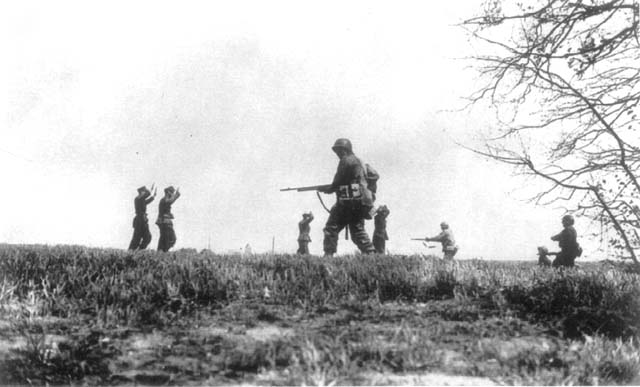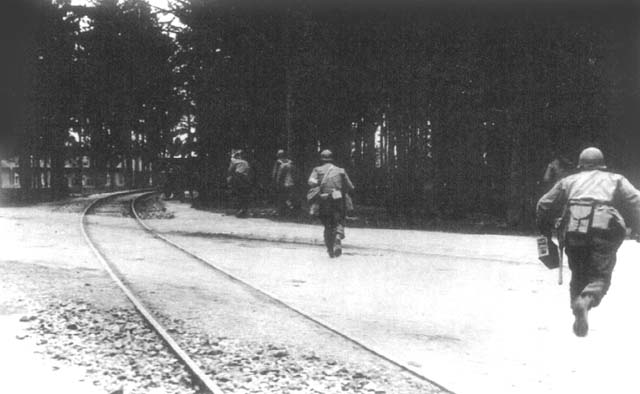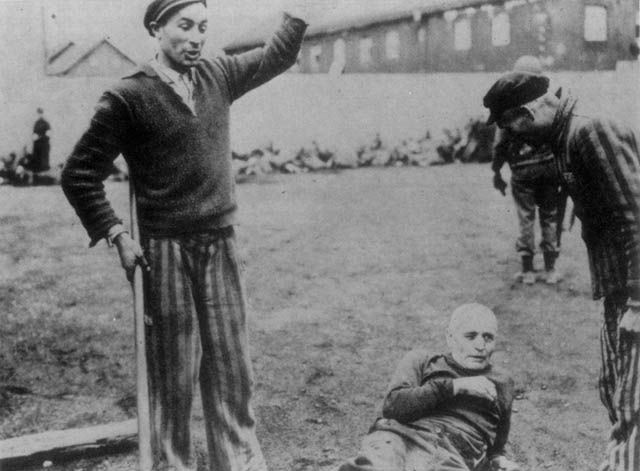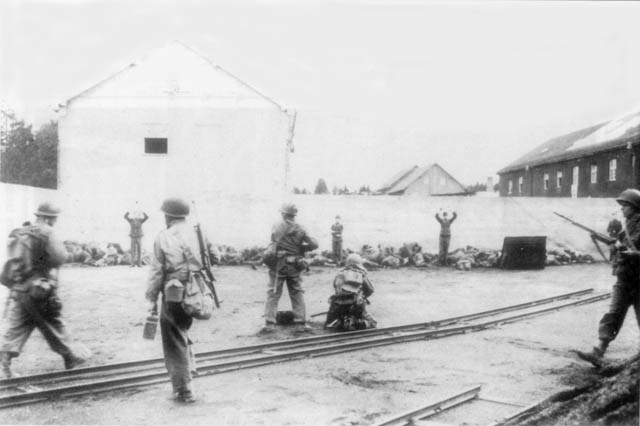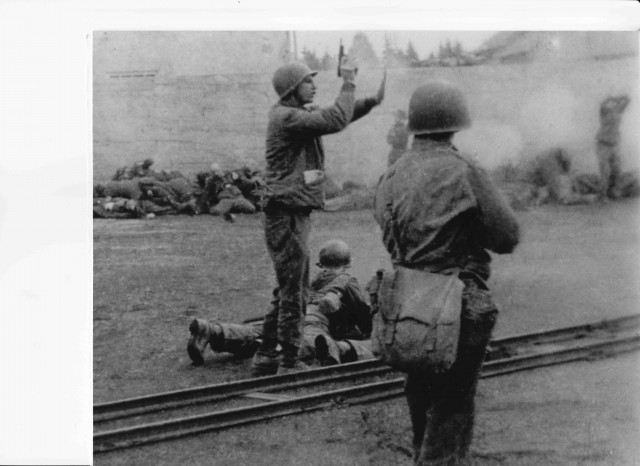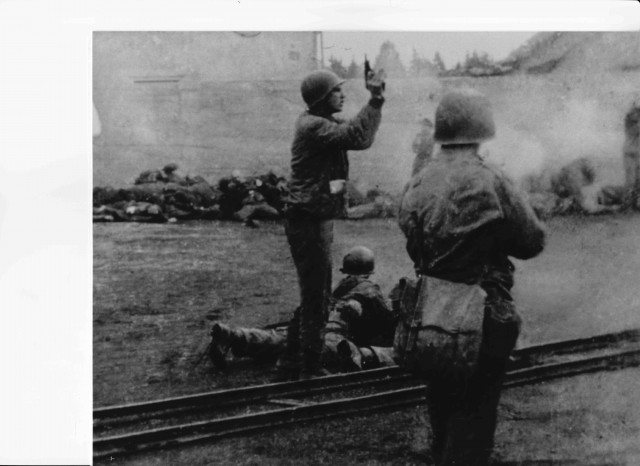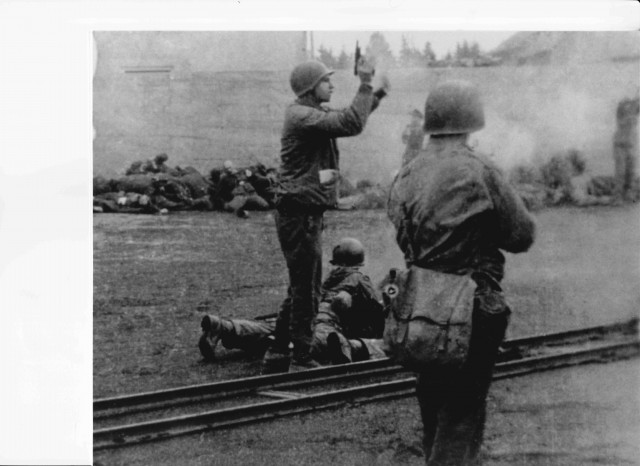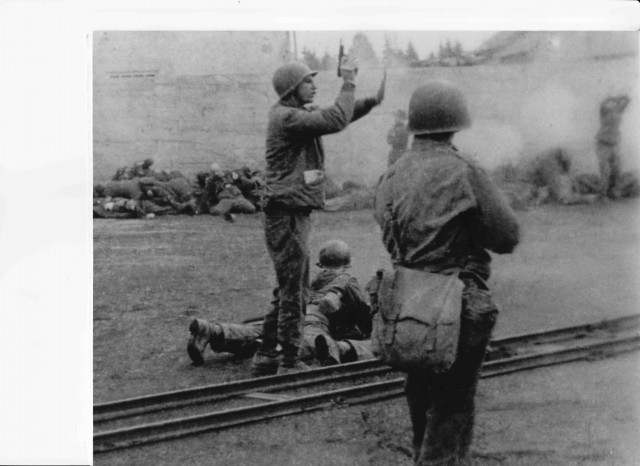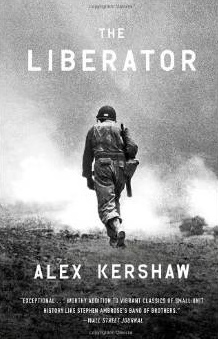To commemorate the 70th anniversary of the liberation of Dachau on April 29th, Alex Kershaw has sent us an extract from his book The Liberator You can find Part 1 here
AGAIN, THERE WAS a haunting silence. There were no more gunshots. Finally, the tens of thousands of inmates realized that the Americans had liberated the camp. The SS had clearly been dealt with. At last, it was safe to venture from their barracks. A prisoner called Kupfer-Koberwitz lay wounded in the inmates’ sick quarters and now noted the reactions of his fellow survivors in a secret diary: “Everyone starts to move – the sick leave their beds, the nearly well and [others] jump out of the windows, climb over the wooden walls. Everyone runs to the roll-call place. One hears yelling and cheers of hooray….”[i]
The camp then erupted. Inmates began to shout and scream, producing a spine-chilling roar,[ii]an unearthly howl of joy and rage.[iii] A sound Sparks would never forget.
Inmates soon surrounded some of Sparks’ men. A Pole called Walenty Lenarczyk, Inmate No. 39272 at Dachau, helped others grab Thunderbirds and lift them up. There were soon over a hundred prisoners clustered around the Americans, trying to kiss their hands and their uniforms with the soft felt Thunderbird patches on their shoulders. “All we could think about were Americans,” recalled Walenty. “For the past six years we had waited for the Americans, and at this moment the SS were nothing. It was truly our second birthday.”[iv]
Lenarczyk saw four German SS guards making a run for it. The Americans could not open fire because prisoners surrounded them. Other inmates swarmed around the fleeing SS men, one of whom elbowed a prisoner out of his way. The inmates then attacked en masse and the SS men were killed, in all likelihood stamped to death.
Two inmates preparing to kill a fallen SS guard with a shovel. In background rows of machine gunned German guards can be seen lying in piles along the base of the hospital wall. A large hospital building can be seen above right. The man on the left is same individual as above. (Photographer unknown, probably T/4 Arland B. Musser, US Signal Corps. Reproduced from “Day of the Americans” by Nerin Gun.)
Elsewhere in the camp, victims suddenly became victimizers and in several instances beat other SS men, their Kapos and informers to pulps with fists, sticks and shovels. It was as if with every stabbing action, every limb broken, every punch and kick, they were repaying each day of suffering.[v]The Thunderbirds did little to intervene, turning their backs on two inmates beating a German guard to death with a shovel. The German, it was later learned, had castrated a prisoner.[vi]In another incident, Russian prisoners grabbed a German by his legs and tore him apart, his bones cracking loudly.[vii]
25-YEAR-OLD Marguerite Higgins and men from the 42nd Rainbow Division arrived that morning from a different direction to the Thunderbirds. At the main entrance to the Dachau complex, they encountered tall and slim SS 2nd Lieutenant Heinrich Wicker of the Totenkopfverbande. 23-year-old Wicker had earlier that morning met with his mother, sister, fiancée, and two-year-old son inside the Dachau complex. They would never see him again.
Accompanied Victor Maurer, a Red Cross representative, Wicker formally surrendered the Dachau complex to Brigadier General Henning Linden, the 42nd Infantry Division’s assistant division commander. It is assumed that Wicker was killed later that afternoon, either by inmates or the liberators he had surrendered to.[viii]
Linden and his party then entered the complex itself. Higgins later described in a world exclusive how inmates called out to her in several different languages.
“Are you Americans?” asked one.
Higgins nodded.
Starving men, many in tears, swept forward.
“Long live America!” they cried.
Some were too weak to walk so they crawled toward Higgins. The first to reach her was a Polish Catholic priest.[ix]He threw his arms around her neck and kissed her several times. She did not resist. Then she stepped back and pulled off her helmet and goggles. [x] Her blond hair fell free. Her pretty young face with its slightly snub nose was visible.
“My God! My God! It’s a woman. Pardon Madame!”[xi]
SPARKS DID NOT know that Higgins and soldiers from the 42nd Infantry Division had entered the Dachau complex. [xii] Buildings and barracks blocked his view as he made his way to the coal yard where his men had lined up SS men against an eight foot high stucco wall.[xiii] Lieutenant Bill Walsh was present, having calmed down somewhat and been restored to his command by Sparks.[xiv] I Company’s Lieutenant Daniel Drain set up a machine gun. A corporal, Martin J. Sedler, stood next to the gun. 19-year-old Private William C. Curtin lay down behind the gun and aimed it at around a hundred SS men standing against the stucco wall.
To Sparks, the situation now seemed to be firmly under control.[xv] The SS were under guard. Others were being rounded up elsewhere. Thunderbirds had been posted at various places around KZ Dachau to prevent anyone getting in or out, including at the main gate.
The photo above shows about 60 dead or wounded German guards lying at the base of a long wall. Only about one fourth of the total length of the wall is visible. A machine gunner crouches over a model 1919A4 machine gun, center foreground. The four German soldiers still standing and three or four of their fallen comrades at left who are still alive were shot only seconds after this photo was taken. A hospital building can be seen at right. (Photo by Arland B. Musser, US Signal Corps. Courtesy National Archives, Washington D.C.)
A private approached Sparks.
“Colonel, you should see what we found,” said the private.[xvi]
Sparks left with the soldier.
Once Sparks had departed, time seemed to speed up as if in a dream according to one of the I Company officers in the coal yard, 25-year-old Lieutenant Jack Busheyhead, a Cherokee Indian.[xvii]
Lieutenant Walsh ordered a private to keep his BAR machine gun trained on the SS troops lined up at the wall. If they didn’t stay back, the private was to open up on them.[xviii] Some of the SS arrogantly refused to stay back against the wall, another Thunderbird recalled, and to keep their hands above their heads.
Others muttered in German.[xix]
“Keep your Goddamn hands up and stay back,” someone shouted.[xx]
Lieutenant Walsh then lined up riflemen and called for Tommy gunners.[xxi]
Curtin began to feed the belt into his machine gun. He pulled back a lever to cock it. It was ready to fire.
“Let them have it,” said Walsh.
Walsh opened up with his pistol.
Curtin fired three bursts, he later claimed, maybe fifty rounds in all.[xxii] Then his machine gun jammed.
A medic called Peter Galary spotted an SS man, clearly an officer.
“Drop to the ground,” shouted the SS officer.
Most of the SS did so. But three still remained standing, utterly defiant.[xxiii]
Galary grabbed for a fellow Thunderbird’s gun.
“Fire it over here.”
Galary wanted to kill the SS officer because he seemed to be the leader but his fellow Thunderbird wouldn’t let go his gun.[xxiv]
The firing continued.
Lieutenant Busheyhead also opened up on the SS, spraying them with his carbine.[xxv]It was probably no more than ten seconds, but it seemed like much longer. They fired from left to right and right to left.[xxvi]
An SS man beside Hans Linberger fell on top of him.
“The pigs are shooting at my stomach,” the man cried.
Blood from the man covered Linberger’s face.
An SS officer called Weiss was not far away.
“Stay calm, we die for Germany,” he said.[xxvii]
Sparks was by now around ten yards beyond the stucco wall. At the sound of gunfire, he wheeled around and ran back toward the coal yard. It took him perhaps five seconds to realize what was going on.[xxviii] Meanwhile, T/4 Arland B. Musser from the 163rd Signal Photo Corps snapped photographs. He recorded private Lee moving with his M-1 toward the M Company machine gun and then, incredibly, he snapped Sparks as he ran to the middle of the coal yard, pulled his .45 from his holster, thrust out his palm, screamed for his men to stop and fired shots into the air.[xxix]
Colonel Felix Sparks, Dachau, stopping the massacre (source Alex Kershaw)
The firing had got everyone’s attention and stopped the shooting.[xxx]
Sparks’ men looked at him.
“There will be no more firing,” said Sparks, “unless I give the order.”[xxxi]
He saw Curtin behind the machine gun. He ran over and kicked him in the back, knocking him forward onto the coal-dusted ground. Then he grabbed him by the collar and pulled him away from the gun.
“What the hell are you doing?” shouted Sparks.
Curtin began to cry. [xxxii]
“Colonel,” he blurted, “they were trying to get away.”[xxxiii]
There were a few moments of silence.[xxxiv]
Sparks turned to Lieutenant Daniel F. Drain from M Company. He was in charge of the machine gun squad and now stood nearby in a state of shock.
“Lieutenant,” said Sparks, “let’s not have any more firing here.”[xxxv]
The Germans lay in piles at the wall. At least seventeen had been killed.[xxxvi] As many as seventy-five men were on the ground and many looked badly wounded.[xxxvii] A Thunderbird ordered the surviving SS to stand up. Most were able to get to their feet. A private standing in the coal yard could not understand how they had survived, with so many shots fired.[xxxviii] Only now did other bystanders realize the enormity of what had just happened. It was wrong to shoot the Germans as they stood with their hands in the air, no matter what they had or had not done.
Corporal Henry Mills, standing nearby, was sickened by the killings.
I’ve been here too long. I’ve to go home now… I want to see my mom.
22-year-old Mills had not seen his mother for three years.[xxxix]
We came over here to stop this bullshit, and now here we got somebody doing the same thing.[xl]
It was not the American way of fighting.[xli]
Sparks ordered his men to help the wounded get to the infirmary.[xlii]Some men began to do so. Others did not. They included medic Peter Galary who later admitted that he refused to patch up the Germans he shot.[xliii]Colonel Howard Buechner, the battalion surgeon, also failed to treat any of the wounded according to a subsequent investigation.[xliv]
Among the SS, a man named Jager asked Hans Linberger if he had been hit.[xlv]
No, said Linberger, he had not.
Jager had been shot in his forearm.
Linberger gave Jager some chocolate. He was convinced they were about to be finished off. Then a Thunderbird medic, claimed Linberger, threw some razor blades toward him and others. [xlvi]
“There, finish it yourself,” the medic said.
Jager took a blade and slit his jugular vein.[xlvii]
LEAVING HIS MEN to deal with the wounded SS, Sparks returned toward KZ Dachau’s confinement area with Johnson and Mann. After several minutes, they reached the area’s wire fence. Beyond it, thousands of inmates were still cheering the Americans.[i]
In a nearby barracks, a 21-year-old German Jew, Jack Goldman, listened to the commotion.[ii] When the Americans came, he did not have any clothing, just a soiled blanket he wrapped around him to try to fend off the cold. He knew English but when he tried to talk he couldn’t say a word. He was mute, too affected to speak. He saw a young Jewish Hungarian woman take off her shirt, pull out a needle and thread, and begin to sew it into a pair of underpants for him, his first clothes as a free man.[iii] Over 400,000 thousand of her fellow Hungarian Jews had been killed in less than two months in 1944 alone.
Sparks’ men would later bring Goldman and others some scraps of food they found in a nearby warehouse. Goldman was also handed a discarded Waffen SS uniform to put over his underpants. He refused to take the black jacket and trousers. So they found him a green uniform. That felt a lot better.[iv]
Goldman and his fellow inmates were no longer considered vermin. Sparks’ men asked him his name.[v] He was no longer a number. He was a human being.[vi]
[i] Karl Mann, unpublished WW11 memoir. Also Karl Mann, interview with author.
[ii] Jack Goldman, interview with author. Goldman’s Auschwitz camp number was 69970 – he would never forget it because it was tattooed on his arm. More than 400,000 numbers were assigned at Auschwitz. The tattoos were introduced so that the authorities could identify the corpses of registered prisoners who had died.
[iii] Sylvia Rothchild, Voices from The Holocaust, NAL, New York, 1981, p. 164.
[iv] Ibid.
[v] Jack Goldman, interview with author.
[vi] Rocky Mountain News, 29 April 2003.
You can follow Alex on Facebook. You can buy The Liberator via Amazon
[i] Dachau and Nazi Terror, 1933-1945, Studies and Reports II, Dachau, 2002, p. 152.
[ii] Felix Sparks, Diary of a Battalion Commander, p. 142.
[iii] Felix Sparks, interview with author.
[iv] Whitaker, I.G. Report, Walenty Lenarczyk testimony, p.51, National Archives.
[v] AAR, NA.
[vi] New Orleans Times Picayune, May 27 2001.
[vii] 45th Infantry Division News, May 13 1945.
[viii] www.scrapbookpages.com. Dr. Juergen Zarusky, “Dachauer Hefte Nr. 13”.
[ix] New York Herald Tribune, 1 May 1945.
[xi] Antoinette May, Witness to War, Penguin, New York, 1983, p.90.
[xii] Felix Sparks, Dachau and its Liberation, 157th Infantry Association, 20 March 1984.
[xiv] Felix Sparks, private correspondence, 2 February 1982.
[xv] Boston Globe, 2 July 2001
[xvi] Felix Sparks, interview with Flint Whitlock, 1996.
[xvii] IG Report, National Archives. See also Howard C. Buechner, Dachau – The Hour of the Avenger, Thunderbird Press, Metairie, Louisiana, USA, 1986, pp 78-79.
[xviii] Ibid.
[xix] John Lee, Action at the Coal Yard Wall, Second Platoon newsletter, April 2001, issue #20.
[xx] John Lee, Action at the Coal Yard Wall, Second Platoon newsletter, April 2001, issue #20.
[xxi] Whitaker IG report. National Archives.
[xxii] Ibid.
[xxiii] Karl Mann, interview with author.
[xxiv] Frank Whitlock, Rock of Anzio, p.365.
[xxv] Whitaker, I.G. Report, National Archives.
[xxvi] Boston Globe, 2 July 2001
[xxvii] Erich Kern, Verbrechen am deutschen Volk, Eine Dokumentation alliierter Grausamkeiten, Gottingen, 1964, pp.314-316.
[xxviii] Karl Mann, interview with author. Also see Karl Mann, unpublished memoir of WWII experiences.
[xxix] Felix Sparks, interview with author.
[xxx] Karl Mann, unpublished WW11 memoir.
[xxxi] Felix Sparks, interview with author.
[xxxii] Boston Globe, 2 July 2001
[xxxiii] Felix Sparks, Dachau and its Liberation, 157th Infantry Association, 20 March 1984.
[xxxiv] New Orleans Times Picayune, May 27 2001.
[xxxv] Frank Whitlock, Rock of Anzio, p. 365.
[xxxvi] Felix Sparks, interview with author.
[xxxvii] Whitaker report, IG Report National Archives.
[xxxviii] Whitaker investigation IG Report. NA
[xxxix] James Strong documentary, KZ Dachau.
[xl] Ibid.
[xli] IG Report [Inspector General], National Archives.
[xlii] IG Report, National Archives.
[xliii] Rock of Anzio, p.365.
[xliv] IG Report.
[xlv] Erich Kern, Verbrechen am deutschen Volk, Eine Dokumentation alliierter Grausamkeiten, Gottingen, 1964, pp.314-316.
[xlvi] IG Report, NA. See also the excellent account of the shooting: “That is not the American Way of Fighting”, Wolfgang Benz and Barbara Distel, eds., Dachau and Nazi Terror II, Dachau 2002, pp. 132-160.
[xlvii] Erich Kern, Verbrechen am deutschen Volk, Eine Dokumentation alliierter Grausamkeiten, Gottingen, 1964, pp.314-316.
